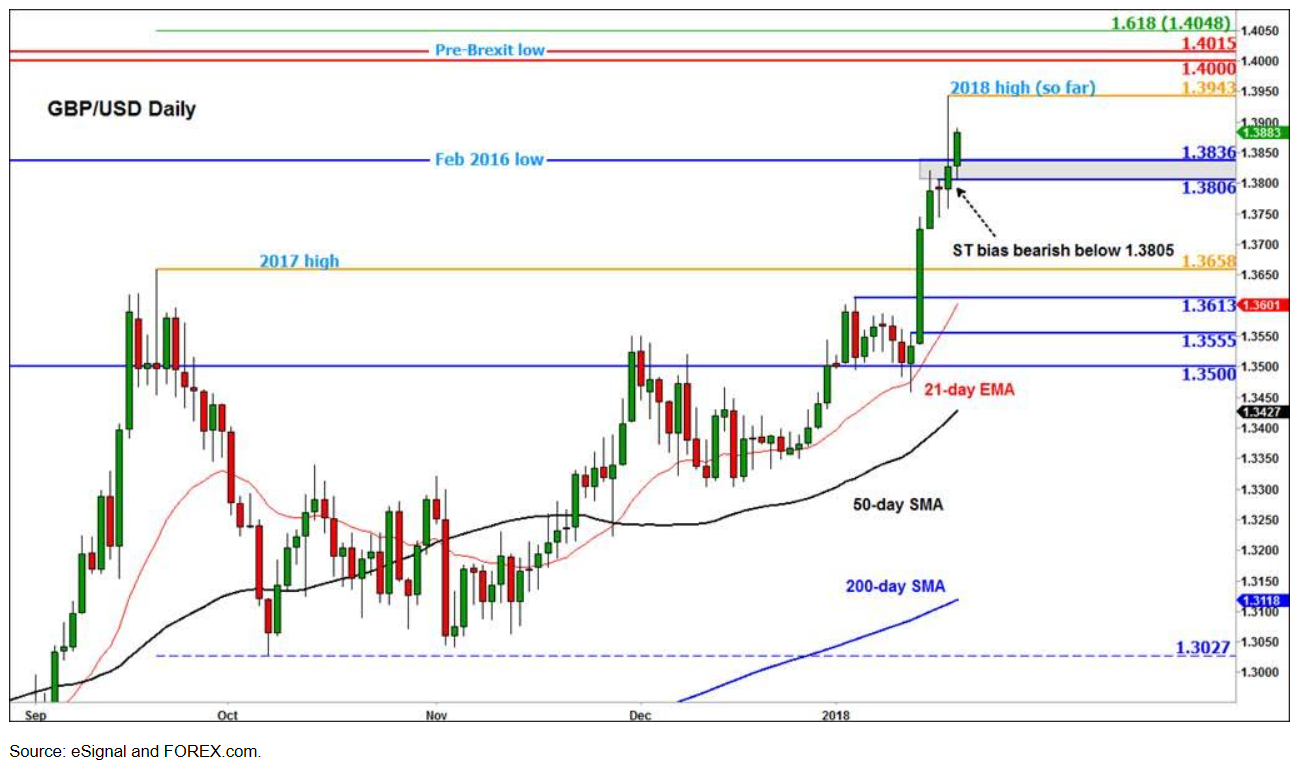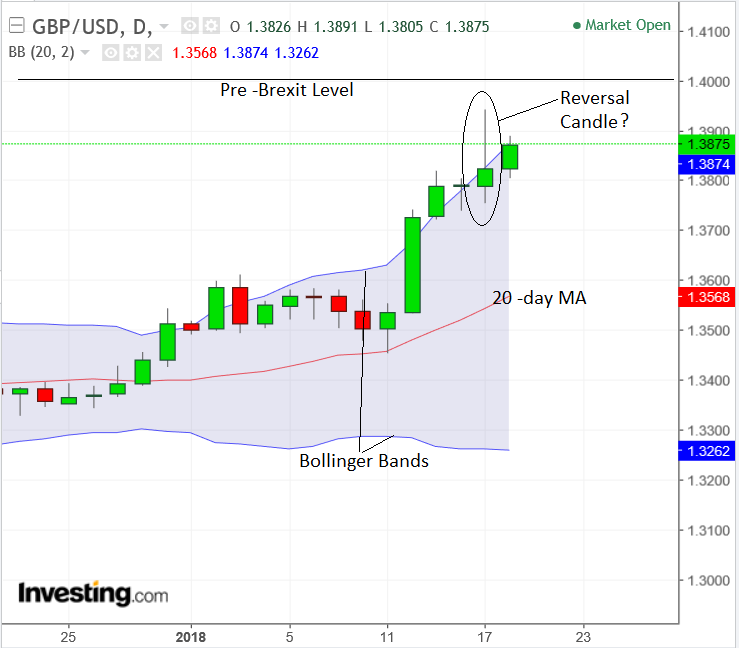Pound / Dollar Rate Eyes Assault on 1.40

The Pound-to-Dollar exchange rate has powered higher versus the Dollar and is now close to levels where the risks increase of a pull-back or reversal.
After a blinding run higher, GBP/USD now sits just below the key 1.40 level having today attained an 18-month high of 1.3945.
Although there is no definitive evidence yet that the uptrend is reversing some analysts are growing sceptical the pair can eke out substantially more gains at these already-high levels.
Yet having said that, assuming history repeats itself, GBP/USD is overstretched according to our models and showing compelling signs it could reverse and pull-back.
'Back to the Lows'
One major hindrance for the pair will be the pre-Brexit level at circa 1.4000 as this is likely to attract a lot of supply from traders relieved the market has rallied back up to where it was before the catastrophic (for the Pound) Brexit vote.
For example, those who did not liquidate their bullish bets, otherwise known as long positions, before the vote, or who betted on the opposite outcome, may now be breathing a sigh of relief that their positions have recovered to close to breakeven (assuming an entry point around 1.4000).
As such, and in line with trader psychology, they will be tempted to close their positions out of fear the market may drop back down and they will be underwater again, and so there is likely to be substantially more supply of Sterling at current or higher levels as they sell their Pounds, which suggests the going will, therefore, probably get tougher for Sterling bulls.
"1.4000/15 is the next bullish objective. This psychologically-important hurdle was the last low hit just before Brexit. Once support, this could potentially turn into a long-term resistance level," says Forex.com market analyst Fawad Razaqzada.
Analyst Robin Wilkin at Lloyds Bank is also in favour of a retracement in Sterling, but is wary that current momentum will allow for 1.40 to be breached:
"Our studies continue to look for a pullback from the 1.3900 region. However, price action is providing little support to this view. As such, we couldn’t rule out a push towards next resistance in the 1.4000-1.4030 region."
Advertisement
Get up to 5% more foreign exchange by using a specialist provider to get closer to the real market rate and avoid the gaping spreads charged by your bank when providing currency. Learn more here.
Dollar Weakness Could Turn Into a 'Strength'
The pullback from the 1.3942 highs coincided with market-based estimates showing a jump in the probability that the Federal Reserve will raise interest rates three times this year.
The probability that this would happen increased from 48% to 55% at the time of the recovery in the US Dollar, which brought GBP/USD down from its highs.
Interestingly, Forex.com's Razaqzada speculates that given there was no direct event which seemed to be the catalyst for the rise in expectations, one possible explanation could be the Dollar's recent bout of weakness.
A weak Dollar will have a positive effect on inflation by increasing the price of imports, and it may be the market suddenly decided to factor this in when it recalibrated expectations on Tuesday.
This would make sense given the markets current obsession with the opposite effect of the same principle in the Eurozone, where the substantially stronger Euro is weighing on inflation expectations and raising shadows of doubt about the progress of monetary policy tightening there.
A Reversal Pattern at the Highs?
Whilst any veteran stock trader will tell you it's dangerous to pick tops (or bottoms), the confluence of evidence above, in conjunction with our own chart analysis does seem to start tilting the odds in favour of, at least the possibility of a correction evolving.
The shape of Wednesday's bar in the form of a Japanese candlestick, for example, looks quite bearish, for it shows a rise and then a swift rejection from the highs and the pair closing back down near the lows of the day, and this sort of profile is associated with short-term tops.
The equivalent Japanese candlestick pattern is the shooting star, which has bearish connotations, especially if followed by a down day.
The range of the day is also rather long, which is another characteristic of reversal days, however, it is not unusually long as would be the case in a very high probability reversal pattern, as these represent markets pushing to extremes and exhaustion.
One final characteristic, however, does heighten the possibility we may witness a pull-back from Wednesday's bar, and that is the relationship of the bar's range with that of a common chart indicator called a Bollinger band.
When a long topping candle such as that which formed on Wednesday stretches quite far above the top of the upper Bollinger band then it is a sign the exchange rate will probably reverse. The acid test is whether more than half of the bar is sticking out above the Bollinger band or not - if it is then that heightens the chances it is a reversal. In this case it does.
Bollinger bands, for those not familiar with them, are merely bands set at two standard deviations above and below the 20 days moving average (MA) of the exchange rate.
Yet two pieces of evidence suggest we should be cautious before assuming the pair will fall: the first is that activity on Thursday and today so far (Friday) has been bullish and the pair continues rising when it ought not in the case of a reversal; and second, that Wednesday's bar was not very long, only longer than average, again for a really bearish signal better it had been longer.
Thus overall there is still compelling evidenc to suggest the uptrend remains intact for now.
Get up to 5% more foreign exchange by using a specialist provider to get closer to the real market rate and avoid the gaping spreads charged by your bank when providing currency. Learn more here.






